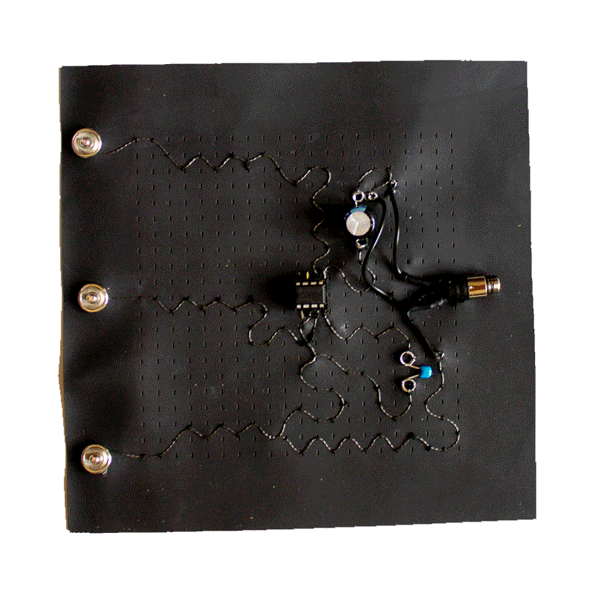Final Project: Stitch Synth#
Stitch Synth is an e-textile, modular, analog synthesizer. Which is a complicated way of saying it’s a collection of electronic circuits that make sound, where hard circuit boards are replaced with fabrics, and wires and resistors replaced with conductive threads and fabrics.

A research project on e-textile circuits and soft interfaces for making noise with electronics, Stitch Synth is motivated by the hidden history of women in electronics (and electronic music, and more) and the potential for e-textiles to develop new ways of making electronic circuits, and new ways to interact with them.

PLAY / MAKE / LEARN / HACK#
PLAY#
Playing Stitch Synth is easy! Snap the modules together, plug it into a speaker, and touch / press / pull the sensors to make different sounds.
Go to the PLAY page for more information on how to play Stitch Synth.
MAKE#
You can make your own Stitch Synth! Access to certain toosl - a laser cutter, embroidery machine, and a soldering iron - will help, but you can make some or even all of the modules without them.
For detailed instructions go to the MAKE page.
LEARN#
Stitch Synth is an analog synthesizer. With no computers, no coding, not even a microcontroller, all the sounds are generated by logic chips (aka CMOS ICs) working in combination with capacitors and resistors.
The LEARN page has more detail about how Stitch Synth actually works, including circuit diagrams, and links to more in-depth resources on the circuits that make it all work.
Big influences for Stitch Synth were Handmade Electronic Music by Nicolas Collins, and the Logic Noise on Hackaday. I highly recommend these if you want to get into making your own analog synths!
HACK#
There are lots of ways to add, change, adapt Stitch Synth. The HACK page gives you some ideas on where to go from here, and tips on developing e-textile projects.
Project Development#
For a detailed log of how the project was developed:
- The Implications and Applications assignment goes through how and why this topic was chosen.
- In the project diary there’s a detailed record of each week’s research, prototyping, and tools/machines used.
Notes on Design#
Zero (ish) Waste Design#
Over the course of Fabricademy I learned a lot about zero waste / sustainable design, and got to work alongside lots of interesting people making real progress in this area. So while sustainable fashion isn’t my main area of focus, it did inform how I made Stitch Synth
- Stitch Synth’s modules are square, which means they can be cut out of a piece of fabric without leaving awkwardly shaped leftover parts. It’s also possible to arrange all the modules into one big square to be laser cut out of one piece with minimal waste
- To achieve loops and curved patterns, I used thread instead of laser cutting curved fabric strips. This means I only used as much thread as needed, and again didn’t have leftover scraps in unusable shapes.
Expressive Electronics#
Stitch Synth is played by touch, but in a more expressive way than, say, twisting a dial or pressing a key. Soft interfaces that can be stroked or squeezed are, I think, a new avenue for electronics that may become more popular as we start truly ‘wearing’ electronics on the body.
Why not a wearable synth?#
Although I’m really interested in the wearable potential of e-textiles, and wearing an instrument on the body opens up new possibilities for how it can be played, I also have a background in public engagement with art/science, and I’ve seen how artwoks and installations can be more intimidating to people if you have to put them on first (and also be the centre of attention while wearing and playing it). So to keep the barrier to engagement as low as possible, for this project I decided to keep it off the body. But for future projects I do hope to make wearable synths ☉‿⊙
Thanks#
Big thanks to the Fabricademy coordinators - Cecilia, Anastasia and Fiore, and Teresa, Wendy, Stephanie and Irene in our Amsterdam class. And also everyone at Fablam Amsterdam who helped me and taught me new things during Fabricademy, and friends and family who gave me advice or just listened to me talk endlessly about electronics ◔ᴗ◔